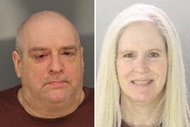Create a free profile to get unlimited access to exclusive videos, breaking news, sweepstakes, and more!
Who Was The 'Yorkshire Ripper,' The Brutal Serial Killer Who Terrorized The UK In The 1970s?
The brutal killer was interviewed by police multiple times but still evaded capture for years.
It took a massive and costly years-long hunt for police to capture the man known as the "Yorkshire Ripper" — a prolific serial killer who drew comparisons to the infamous "Jack the Ripper" who terrorized Britain nearly a century prior.
While not as notorious as his predecessor, the killer known as the Yorkshire Ripper's brutal tactics targeting women left a similarly bleak mark on England in the 1970s and 80s. At the start of the investigation, police believed this was in fact a new version of Jack the Ripper — one hoaxer even claimed to be the killer, referring to himself as “Jack” in at least one recording sent to investigators during the manhunt. But the killer’s true name — Peter Sutcliffe — is now notorious in England.
Keep reading to learn more about the brutal killer...
Who was Yorkshire Ripper Peter Sutcliffe?
Sutcliffe was born in 1946 in Bingley, Yorkshire into a working-class Catholic family, The Mirror reported.
His father, John Sutcliffe, explained in an archived interview included in the docuseries The Ripper that as a child, his son was clingy toward his mother and preferred her company to the company of other boys, as they “were too big for him.”
He said that his son was a loner who was both “kind” and “timid.”
The budding killer left school at age 15 and worked several odd jobs, including traveling salesman, gravedigger, and factory line worker. By 1975, he’d begun working as a truck driver.
He eventually married a teacher, Sonia, in 1974 and they purchased a house in Heaton, where they lived there until Sutcliffe’s arrest.
Sutcliffe murdered 13 women and attempted to murder seven more in Northern England from 1975 to 1980. His killing spree prompted fear and hysteria across the region as police fruitlessly searched for the killer who instilled fear in people across the country. Northern England went into a near-lockdown and women were encouraged to not go out alone at all as the killings continued — there was even at one point a curfew set for women, which was challenged at the time by feminists.
Sexism and the devaluation of sex workers – Sutcliffe’s targets – made it difficult for the investigators to identify and capture the murderer. Victim-shaming of the murdered women was common, with victims' sex lives and the conditions of their homes were printed right alongside the details of the killings.
How Was the Yorkshire Ripper Caught?
The lengthy investigation concluded when Sutcliffe was finally captured in 1981 after police found him in a car with false license plates along with sex worker Olivia Reivers, who survived the encounter. Within days, Sutcliffe confessed that he was indeed the prolific killer that investigators were hunting.
Sutcliffe's father said his son "was probably the last person in the world you would have expected” to become a serial killer.
Journalist and novelist Joan Smith explains in The Ripper that she discovered a lot of sexism in Sutcliffe’s world.
“When I did a bit of research on his background, the key thing that I noticed is that he grew up in an atmosphere where contempt for women and dislike of women was normalized,” she told producers of the docuseries. “And the idea that women are victims, all of that, was there already.”
Smith claims that a young Sutcliffe witnessed his father beat his mother often and sided with his mom — which in effect led to him being called “a sissy.”
“And I think he identified anything to do with women and femininity as weakness,” Smith added. “And at some point, he switches and becomes a violent man himself. And I think this was his way of being a man.”
RELATED: The Little-Known Story Of The Atlanta Ripper
Police had interviewed him a total of nine times before his arrest.
Smith believes that investigators were wrongly chasing what they believed was a new version of Jack the Ripper — the still-unknown serial killer who murdered at least five women in London during a three-month period in 1888. Sutcliffe’s victims, like those of Jack the Ripper, were often horribly mutilated.
However, Smith believes that it was sexism that led the male investigators to ignore other linked attempted murders of non-sex workers.
Former police officer Bob Bridgestock, who worked on the Sutcliffe investigation, told BBC Radio 4 in 2020 that he "wasn't a very intelligent killer — he was just brutal.”
During his 1981 trial, Sutcliffe claimed that it was voices he heard while working as a gravedigger that told him to kill sex workers. He specifically blamed a voice coming from the headstone of a dead Polish man named Bronisław Zapolski, The Sun reported.
The Yorkshire Ripper's Victims
Sutcliffe was ultimately found guilty of 13 counts of murder for the deaths of Wilma McCann, Emily Jackson, Irene Richardson, Patricia "Tina" Atkinson, Jayne MacDonald, Jean Jordan, Yvonne Pearson, Helen Rytka, Vera Millward, Josephine Whitaker, Barbara Leach, Marguerite Walls, and Jacqueline Hill. He was also convicted of attempting to murder seven other women.
He was handed 20 concurrent life sentences.
Where Is Yorkshire Ripper Peter Sutcliffe Now?
Sutcliffe, who had underlying health issues, died in November 2020 in a hospital after he refused treatment for COVID-19, which he contracted behind bars, the BBC reported. Sutcliffe, who changed his name to Coonan behind bars, was receiving treatment for heart problems and type 2 diabetes when he contracted the deadly illness.
Prior to his death, Sutcliffe was held at the Frankland prison in County Durham, as well as Broadmoor high-security psychiatric hospital.
(This article was originally published on December 16, 2020 and has been updated with new information.)





























